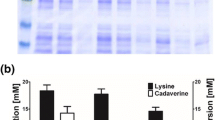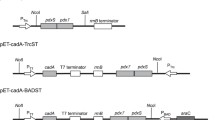Abstract
A whole-cell biocatalytic system for the production of cadaverine from l-lysine has been developed. Among the investigated lysine decarboxylases from different microorganisms, Escherichia coli LdcC showed the best performance on cadaverine synthesis when E. coli XL1-Blue was used as the host strain. Six different strains of E. coli expressing E. coli LdcC were investigated and recombinant E. coli XL1-Blue, BL21(DE3) and W were chosen for further investigation since they showed higher conversion yield of lysine into cadaverine. The effects of substrate pH, substrate concentrations, buffering conditions, and biocatalyst concentrations have been investigated. Finally, recombinant E. coli XL1-Blue concentrated to an OD600 of 50, converted 192.6 g/L (1317 mM) of crude lysine solution, obtained from an actual lysine manufacturing process, to 133.7 g/L (1308 mM) of cadaverine with a molar yield of 99.90 %. The whole-cell biocatalytic system described herein is expected to be applicable to the development of industrial bionylon production process.






Similar content being viewed by others
References
Anastassiadis S (2007) l-lysine fermentation. Recent Pat Biotechnol 1:11–24
Buschke N, Schröder H, Wittmann C (2011) Metabolic engineering of Corynebacterium glutamicum for production of 1,5-diaminopentane from hemicellulose. Biotechnol J 6(3):306–317
Fothergill JC, Guest JR (1977) Catabolism of l-lysine by Pseudomonas aeruginosa. J Gen Microbiol 99:139–155
Hermosín I, Chicón RM, Cabezudo MD (2003) Free amino acid composition and botanical origin of honey. Food Chem 83:263–268
Kind S, Jeong WK, Schröder H, Zelder O, Wittmann C (2010) Identification and elimination of the competing N-acetyldiaminopentane pathway for improved production of diaminopentane by Corynebacterium glutamicum. Appl Environ Microbiol 76:5175–5180
Kind S, Jeong WK, Schröder H, Wittmann C (2010) Systems-wide metabolic pathway engineering in Corynebacterium glutamicum for bio-based production of diaminopentane. Metab Eng 12(4):341–351
Kind S, Neubauer S, Becker J, Yamamoto M, Volkert M, Abendroth G, Zelder O, Wittmann C (2014) From zero to hero—production of bio-based nylon from renewable resources using engineered Corynebacterium glutamicum. Metab Eng 25:113–123
Kircher M, Pfefferle W (2001) The fermentative production of l-lysine as an animal feed additive. Chemosphere 43:27–31
Lemonnier M, Lane D (1998) Expression of the second lysine decarboxylase gene of Escherichia coli. Microbiology 144:751–760
Le Vo TD, Ko JS, Park SJ, Lee SH, Hong SH (2013) Efficient gamma-aminobutyric acid bioconversion by employing synthetic complex between glutamate decarboxylase and glutamate/GABA antiporter in engineered Escherichia coli. J Ind Microbiol Biotechnol 40(8):927–933
Mimitsuka T, Sawai H, Masahiro Hatsu, Yamada K (2007) Metabolic engineering of Corynebacterium glutamicum for cadaverine fermentation. Biosci Biotechnol Biochem 71:2130–2135
Nishi K, Endo S, Mori Y, Totsuka K, Hirao Y (2005) Method for producing cadaverine decarboxylase. US Pat US 2005(0003497):A1
Park JH, Lee KH, Kim TY, Lee SY (2007) Metabolic engineering of Escherichia coli for the production of l-valine based on transcriptome analysis and in silico gene knockout simulation. Proc Natl Acad Sci USA 104:7797–7802
Park SJ, Kim EY, Noh W, Oh YH, Kim HY, Song BK, Cho KM, Hong SH, Lee SH, Jegal J (2013) Synthesis of nylon 4 from gamma-aminobutyrate (GABA) produced by recombinant Escherichia coli. Bioprocess Biosyst Eng 36:885–892
Park SJ, Kim EY, Noh W, Park HM, Oh YH, Lee SH, Song BK, Jegal J, Lee SY (2013) Metabolic engineering of Escherichia coli for the production of 5-aminovalerate and glutarate as C5 platform chemicals. Metab Eng 16:42–47
Park SJ, Jang Y-A, Lee H, Park A-R, Yang JE, Shin J, Oh YH, Song BK, Jegal J, Lee SH, Lee SY (2013) Metabolic engineering of Ralstonia eutropha for the biosynthesis of 2-hydroxyacid containing polyhydroxyalkanoates (PHAs). Metab Eng 20:20–28
Park SJ, Oh YH, Noh W, Kim HY, Shin JH, Lee EG, Lee S, David Y, Baylon MG, Song BK, Jegal J, Lee SY, Lee SH (2014) High-level conversion of l-lysine into 5-aminovalerate that can be used for nylon 6,5 synthesis. Biotechnol J 9:1322–1328
Pukina AV, Boeriu CG, Scott EL, Sanders JPM, Franssena MCR (2010) An efficient enzymatic synthesis of 5-aminovaleric acid. J Mol Catal B Enzym 65:58–62
Nanami S, Takashi M, Hideki S, Kenji S (2014) Method for producing cadaverine. WO 2014(0004576):A1
Neely MN, Dell CL, Olson ER (1994) Roles of LysP and CadC in mediating the lysine requirement for acid induction of the Escherichia coli cad operon. J Bacteriol 176:3278–3285
Okai N, Takahashi C, Hatada K, Ogino C, Kondo A (2014) Disruption of pknG enhances production of gamma-aminobutyric acid by Corynebacterium glutamicum expressing glutamate decarboxylase. AMB Express 4:20
Qian ZG, Xia XX, Lee SY (2011) Metabolic engineering of Escherichia coli for the production of cadaverine: a five carbon diamine. Biotechnol Bioeng 108(1):93–103
Revelles O, Espinosa-Urgel M, Fuhrer T, Sauer U, Ramos JL (2005) Multiple and Interconnected Pathways for l-Lysine Catabolism in Pseudomonas putida KT2440. J Bacteriol 187:7500–7510
Schneider J, Wendisch V (2011) Biotechnological production of polyamine by bacteria: recent achievements and future perspectives. Appl Miocrobiol Biotechnol 91:17–30
Volkert M, Zelder O, Ernst B, Jeong WK (2010) Method for fermentatively producing 1,5-diaminopentane. US Pat US 2010(0292429):A1
Yamamoto Y, Miwa Y, Miyoshi K, Furuyama J, Ohmori H (1997) The Escherichia coli ldcC gene encodes another lysine decarboxylase, probably a constitutive enzyme. Genes Genet Syst 72(3):167–172
Zelder O, Jeong WK, Klopprogge C, Herold A, Schroeder H (2007) Process for the production of cadaverine. WO 2007(113127):A1
Acknowledgments
This work was supported by Industrial Strategic Technology Development Program (10047910, Production of biobased cadaverine and polymerization of Bio-polyamide 510) funded by the Ministry of Trade, Industry & Energy (MOTEI, Korea) and 2014 Research Fund of Myongji University.
Author information
Authors and Affiliations
Corresponding authors
Electronic supplementary material
Below is the link to the electronic supplementary material.
Rights and permissions
About this article
Cite this article
Oh, Y.H., Kang, KH., Kwon, M.J. et al. Development of engineered Escherichia coli whole-cell biocatalysts for high-level conversion of l-lysine into cadaverine. J Ind Microbiol Biotechnol 42, 1481–1491 (2015). https://doi.org/10.1007/s10295-015-1678-6
Received:
Accepted:
Published:
Issue Date:
DOI: https://doi.org/10.1007/s10295-015-1678-6




